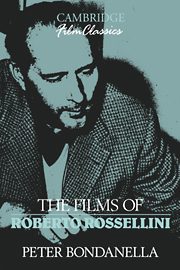Book contents
- Frontmatter
- Contents
- List of Illustrations
- Preface
- 1 Rossellini and Realism: The Trajectory of a Career
- 2 L'uomo dalla croce: Rossellini and Fascist Cinema
- 3 Roma città aperta and the Birth of Italian Neorealism
- 4 Paisà and the Rejection of Traditional Narrative Cinema
- 5 La macchina ammazzacattivi: Doubts about the Movie Camera as a Morally Redemptive Force
- 6 Viaggio in Italia: Ingrid Bergman and a New Cinema of Psychological Introspection
- 7 Il generale Della Rovere: Commercial Success and a Reconsideration of Neorealism
- 8 La prise de pouvoir par Louis XIV: Toward a Didactic Cinema for Television
- Notes
- Chronology
- Filmography
- Bibliography
- Index
5 - La macchina ammazzacattivi: Doubts about the Movie Camera as a Morally Redemptive Force
Published online by Cambridge University Press: 12 January 2010
- Frontmatter
- Contents
- List of Illustrations
- Preface
- 1 Rossellini and Realism: The Trajectory of a Career
- 2 L'uomo dalla croce: Rossellini and Fascist Cinema
- 3 Roma città aperta and the Birth of Italian Neorealism
- 4 Paisà and the Rejection of Traditional Narrative Cinema
- 5 La macchina ammazzacattivi: Doubts about the Movie Camera as a Morally Redemptive Force
- 6 Viaggio in Italia: Ingrid Bergman and a New Cinema of Psychological Introspection
- 7 Il generale Della Rovere: Commercial Success and a Reconsideration of Neorealism
- 8 La prise de pouvoir par Louis XIV: Toward a Didactic Cinema for Television
- Notes
- Chronology
- Filmography
- Bibliography
- Index
Summary
The most creative phase of Italian neorealism took place within a single decade, from the early 1940s to the early 1950s. As we have already seen, a number of works produced during the fascist era are generally considered precursors to neorealist style, including the fictional documentaries by De Robertis, Genina's L'assedio dell' Alcazar, Rossellini's early war trilogy, as well as a few key dramatic films from the early 1940s unconnected with war themes, such as Visconti's Ossessione (Obsession, 1942), Blasetti's Quattro passi fra le nuvole (A Stroll in the Clouds, 1942), and De Sica's I bambini ci guardano (The Children Are Watching US, 1942). There is universal agreement, however, that international recognition of bold neorealist innovation in cinematic art came only with the success of Rossellini's Roma città aperta and Paisà. On the other hand, critics have too often failed to realize that Rossellini and other important directors and scriptwriters identified with the advent of neorealism, such as Michelangelo Antonioni, Vittorio De Sica, Luchino Visconti, and Federico Fellini, began almost immediately after the early success of Rossellini's two films to move Italian cinema beyond a doctrinaire adherence to such critically praised elements of neorealist filmmaking as nonprofessional actors, documentary photography, authentic locations, and socially defined protagonists even as they were winning awards and critical praise at film festivals all over the world. Almost every truly original and innovative Italian director reacted negatively against an attempt on the part of some leftist or progressive critics to dictate what we would probably term today a “politically correct” cinema.
- Type
- Chapter
- Information
- The Films of Roberto Rossellini , pp. 83 - 97Publisher: Cambridge University PressPrint publication year: 1993



